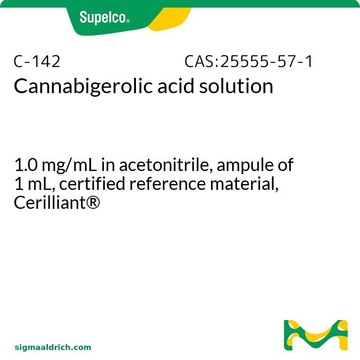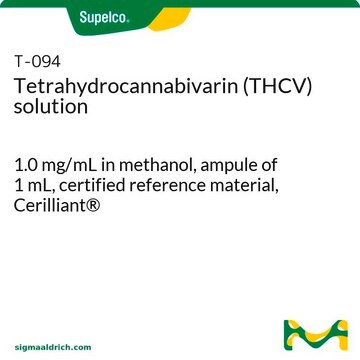T-033
exo-THC solution
1.0 mg/mL in methanol, ampule of 1 mL, certified reference material, Cerilliant®
Synonym(s):
exo-THC solution
About This Item
Recommended Products
grade
certified reference material
Quality Level
form
liquid
feature
Snap-N-Spike®/Snap-N-Shoot®
packaging
ampule of 1 mL
manufacturer/tradename
Cerilliant®
drug control
psicótropo (Spain); Decreto Lei 15/93: Tabela IIB (Portugal)
concentration
1.0 mg/mL in methanol
technique(s)
gas chromatography (GC): suitable
liquid chromatography (LC): suitable
application(s)
cannabis testing
cannabis testing
format
single component solution
storage temp.
−20°C
SMILES string
CCCCCc1cc(O)c2C3CC(=C)CC[C@H]3C(C)(C)Oc2c1
InChI
1S/C21H30O2/c1-5-6-7-8-15-12-18(22)20-16-11-14(2)9-10-17(16)21(3,4)23-19(20)13-15/h12-13,16-17,22H,2,5-11H2,1,3-4H3/t16?,17-/m1/s1
InChI key
AOYYFUGUUIRBML-ZYMOGRSISA-N
Looking for similar products? Visit Product Comparison Guide
General description
Application
- Analysis of 29 hemp-based veterinary products to measure the amount of cannabinoids, terpenes, and heavy metals by liquid chromatography-diode array detection/mass spectroscopy (LC-DAD/MS), headspace gas chromatography-flame ionization detection (HS-GC-FID), and inductive coupled plasma-mass spectroscopy (ICP-MS)
- Identification of 24 non-psychoactive cannabinoids in Cannabis Sativa extracts by liquid chromatography-UV detector and using linear retention index (LRI) approach
Features and Benefits
- Fully characterized under ISO/IEC 17025 and ISO 17034 accreditation
- Accompanied with a comprehensive Certificate of Analysis (CoA) with data on stability, homogeneity, accuracy of concentration, uncertainty, and traceability
- Rigorously tested through real-time stability studies to ensure accuracy and shelf life
- Gravimetrically prepared using qualified precision balances to ensure minimal uncertainty
- Flame sealed under argon into ampoules for long-term shelf life
- Offered in a convenient, DEA-exempt format to improve laboratory efficiency
Legal Information
related product
Signal Word
Danger
Hazard Statements
Precautionary Statements
Hazard Classifications
Acute Tox. 3 Dermal - Acute Tox. 3 Inhalation - Acute Tox. 3 Oral - Flam. Liq. 2 - STOT SE 1
Target Organs
Eyes
Storage Class Code
3 - Flammable liquids
WGK
WGK 1
Flash Point(F)
49.5 °F - closed cup
Flash Point(C)
9.7 °C - closed cup
Certificates of Analysis (COA)
Search for Certificates of Analysis (COA) by entering the products Lot/Batch Number. Lot and Batch Numbers can be found on a product’s label following the words ‘Lot’ or ‘Batch’.
Already Own This Product?
Find documentation for the products that you have recently purchased in the Document Library.
Customers Also Viewed
Articles
The cannabinoids found in the Cannabis plant, commonly referred to as marijuana, have grown in popularity for treating a variety of ailments from arthritis, glaucoma and chronic pain to malnutrition, multiple sclerosis and cancer
Our team of scientists has experience in all areas of research including Life Science, Material Science, Chemical Synthesis, Chromatography, Analytical and many others.
Contact Technical Service













